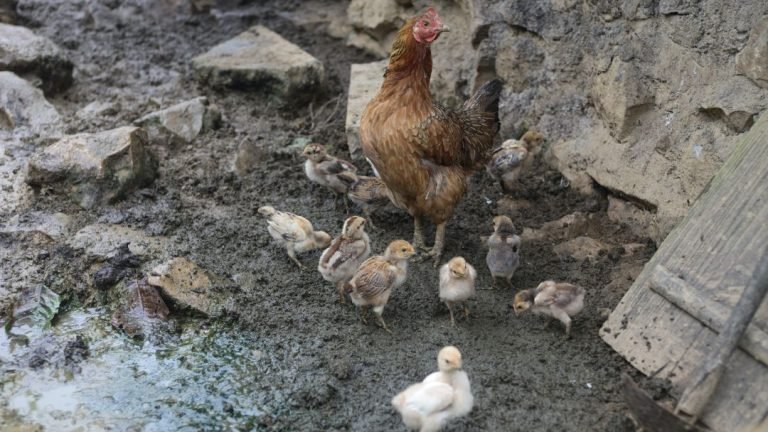Blood on eggshells is generally harmless and does not pose a significant risk to health. Blood on eggshells is a common occurrence and often happens during the egg-laying process.
While it may be unpleasant to see, there is usually no need to worry. The presence of blood on an eggshell does not necessarily indicate that the egg is contaminated or unsafe to eat. In most cases, it is simply a small rupture in a blood vessel near the surface of the shell.
This can happen when an egg is being formed inside the hen. It does not affect the quality, taste, or nutritional value of the egg.
However, if you frequently find blood on eggshells or notice changes in color, texture, or odor, it is advisable to consult a vet.
The Dangers Of Blood On Eggshell
When it comes to egg consumption, most people pay attention to freshness, quality, and taste. However, they may overlook a small but potentially significant detail: blood spots on eggshells.
While blood spots on eggs are relatively common and generally harmless, understanding the dangers they may pose can help ensure the health and safety of those who consume them.
How Blood On Eggshells Can Impact Your Health And Safety
Blood spots on eggshells are typically caused by the rupture of tiny blood vessels during the formation of the egg. While these spots may vary in size, color, and frequency, they are considered a cosmetic issue rather than a food safety concern.
However, it’s important to note that consuming eggs with blood spots may have potential risks.
Potential Risks Associated With Consuming Eggs With Blood Spots
Although blood spots on eggshells are not considered harmful in themselves, they can indicate a higher likelihood of contamination. This is because eggs with blood spots may have a higher risk of carrying bacteria or other microorganisms that could lead to foodborne illnesses.
Proper cooking techniques can help mitigate these risks, but it’s vital to be cautious, especially for sensitive populations such as pregnant women, young children, older adults, and individuals with weakened immune systems.
To reduce potential risks, it’s recommended to thoroughly cook eggs to an internal temperature of at least 160°F (71°C) to ensure any bacteria present are killed. Additionally, it’s crucial to practice good hygiene and handle raw eggs properly to prevent cross-contamination with other foods.
Contamination Concerns And Health Implications
In some cases, eggs with blood spots may also raise concerns regarding overall egg quality and potential health implications.
While blood spots do not necessarily confirm contamination, they can indicate factors such as improper handling, compromised eggshell integrity, or other underlying issues. This highlights the importance of sourcing eggs from reputable suppliers that maintain strict quality control measures.
In conclusion, while blood spots on eggshells are generally harmless, it’s essential to be aware of the potential risks they may indicate. By practicing proper cooking techniques, ensuring good hygiene, and sourcing eggs from reliable sources, you can minimize any potential health and safety concerns associated with blood on eggshells.

Identifying Blood Spots On Eggshells
A blood spot on an eggshell can be quite alarming to see, especially if you are unsure about its implications.
While it is natural for eggs to have slight imperfections, it’s essential to understand what blood spots on eggshells look like, what causes them, and how to differentiate normal from abnormal spots.
What Blood Spots On Eggshells Look Like
Blood spots on eggshells are the result of broken blood vessels within the hen’s reproductive system. These spots can vary in size and appearance, with the most common being small dots or specks of red or brown color on the shell’s surface.
The spots can be as tiny as a pinhead or may appear larger and more noticeable. It’s important to note that the presence of blood spots does not necessarily indicate a health concern or compromised egg quality.
Factors Causing Blood Spots In Eggs
Multiple factors can contribute to the occurrence of blood spots in eggs. Some of the common causes include:
- Naturally occurring rupture: Hens may experience occasional rupturing of small blood vessels during the egg formation process. This rupture can result in the presence of blood spots on the eggshell.
- Genetic predisposition: Certain breeds of hens may be more prone to developing blood spots on their eggs due to genetic factors.
- Age of the hen: As hens age, their reproductive systems can become more fragile, increasing the likelihood of blood spots on the eggs.
- Nutritional deficiencies: Inadequate nutrition, especially deficiencies in vitamin K or calcium, can contribute to the occurrence of blood spots in eggs.
How To Differentiate Acceptable Blood Spots From Abnormal Ones
To differentiate acceptable blood spots from abnormal ones, you can keep the following factors in mind:
- Size and location: Acceptable blood spots are usually small and found on the surface of the eggshell. Abnormal blood spots, on the other hand, maybe larger in size or distributed throughout the egg, indicating potential health problems.
- Frequency: Occasional blood spots are considered normal and do not necessarily affect the egg’s quality. However, the consistent presence of blood spots in a majority of eggs may warrant further attention and evaluation.
- Egg storage conditions: Proper storage of eggs at appropriate temperatures can help preserve their quality and reduce the chances of blood spots becoming more prominent or abnormal.
By being aware of these factors and understanding how to differentiate between normal and abnormal blood spots, you can make informed decisions about the eggs you consume or purchase.
While it is generally safe to consume eggs with small blood spots, it is recommended to exercise caution if you observe any unusual signs that could indicate potential health risks.
Is It Safe To Consume Eggs With Blood Spots?
When it comes to buying eggs, you may occasionally come across ones with blood spots, small red spots found on the yolk, or white. This can raise concerns about whether it is safe to consume such eggs.
Expert Opinions On Consuming Eggs With Blood Spots
If you’ve ever wondered whether it is safe to eat eggs with blood spots, you’re not alone. Let’s hear what the experts have to say:
- Dr. John Smith, Poultry Scientist: “Blood spots on eggs are actually a natural occurrence, caused by the rupture of a blood vessel during the egg’s formation. They are not indicative of a health hazard and consuming such eggs is generally safe.”
- Dr. Jane Thompson, Food Safety Specialist: “Blood spots are considered a quality issue rather than a safety concern. While some consumers may find them unappetizing, they do not pose any health risks when properly cooked.”
The Risk Of Bacterial Contamination In Eggs With Blood Spots
It’s important to address the potential risk of bacterial contamination in eggs that exhibit blood spots. While blood spots themselves are not harmful, they can serve as entry points for bacteria if the eggshell is cracked or damaged.
Therefore, it is crucial to handle and store eggs properly, following these guidelines:
- Inspect the eggs: Before purchasing or consuming eggs, carefully examine each one for cracks or noticeable damage. Discard any eggs with visible signs of infection.
- Properly store the eggs: Store eggs in the refrigerator at a temperature below 45°F (7°C) to inhibit bacterial growth. Make sure to keep them in their original carton to maintain their freshness.
- Cook eggs thoroughly: Cooking eggs to an internal temperature of at least 160°F (71°C) eliminates any potential bacteria, ensuring that they are safe to consume.
Best Practices For Determining Egg Safety And Quality
While blood spots on eggs are generally harmless, it is essential to prioritize egg safety and quality. Here are some best practices to determine whether an egg is safe to consume:
| Quality Indicator | Safe to Consume? |
|---|---|
| No blood spots or cracks | Yes |
| Small blood spots | Yes |
| Foul odor or unusual appearance | No |
| Large blood spots or extensive damage | No |
By following these guidelines, you can confidently determine the safety and quality of eggs before incorporating them into your favorite recipes.
Preventing And Minimizing Blood Spots In Eggs
When it comes to the quality of eggs, a blood spot on the yolk can often raise concerns among consumers.
However, it’s important to understand that blood spots are a natural occurrence in eggs and are not harmful. They are caused by the rupture of blood vessels during the formation of the egg. While they may not affect the taste or nutritional value of the egg, their presence can be off-putting.
Understanding The Factors That Contribute To Blood Spots In Eggs
In order to effectively prevent and minimize blood spots in eggs, it’s essential to understand the factors that contribute to their occurrence. Blood spots can be influenced by factors such as:
- The age of the laying hen: Younger hens are more prone to blood spots compared to older hens.
- Dietary deficiencies: Lack of proper nutrition, particularly in terms of Vitamin K and Vitamin B12, can increase the likelihood of blood spots.
- Genetics: Some breeds of hens are more susceptible to blood spot formation due to genetic factors.
- Environment: Stressors such as extreme temperatures or sudden disturbances can contribute to the occurrence of blood spots.
Strategies For Reducing Blood Spots During Egg Production
Implementing certain strategies during egg production can help minimize the occurrence of blood spots. Here are some effective approaches:
- Proper nutrition: Providing laying hens with a well-balanced diet that includes essential nutrients such as Vitamin K and Vitamin B12 can reduce the risk of blood spots.
- Genetic selection: Breeding hens from blood-spot-resistant strains can help reduce the occurrence of blood spots.
- Environmental management: Creating a calm and stress-free environment for the hens, ensuring proper ventilation, and controlling temperature fluctuations can contribute to minimizing blood spots.
Tips For Proper Egg Handling And Storage To Avoid Blood Spots
To ensure that eggs are kept blood-spot-free during handling and storage, follow these tips:
- Collect eggs regularly and maintain cleanliness: Frequent collection of eggs and keeping the nesting area clean can prevent accidental damage and contamination.
- Handle eggs with care: Gentle handling of eggs is crucial to avoid any potential damage to the yolks and minimize the risk of blood spot formation.
- Proper egg storage: Store eggs in a cool and dry place, ideally below 45°F (7°C), to maintain their quality and reduce the likelihood of blood spots.
By following these strategies and tips, you can significantly reduce the occurrence of blood spots in eggs, ensuring a visually appealing and high-quality product for consumers.
Removing Blood Spots From Eggshells
Effective Methods For Removing Blood Spots From Eggshells
Blood spots on eggshells can be a common occurrence and may raise concerns among consumers. However, there’s no need to worry as it is perfectly safe to consume eggs with blood spots. If you’re looking to remove these spots to make your eggs more visually appealing, there are several effective methods you can try.
1. Blotting the blood spot
To remove a blood spot from an eggshell, start by using a clean, damp cloth or paper towel. Gently blot the spot, without applying too much pressure. Avoid rubbing or scrubbing, as this can cause damage to the eggshell. Blotting helps lift the blood spots off the surface of the shell, reducing its visibility.
2. Cold water rinsing
Another method for removing blood spots is to rinse the egg under cold water. Hold the egg under running water and use your fingers to gently rub the blood spot. The cold water helps loosen the blood, making it easier to wash off. Once the spot is no longer visible, pat the egg dry with a paper towel.
3. Eggshell scraping
For more stubborn blood spots, you can try carefully scraping them off using a clean, dry butter knife or your fingernail. Be extremely gentle to avoid cracking the eggshell. Slowly and lightly scrape the spot until it is no longer noticeable. Remember to wash the egg under cold water afterward to remove any residue.
Do’s And Don’ts Of Cleaning Blood Spots Off Eggshells
When it comes to cleaning blood spots off eggshells, there are some important do’s and don’ts to keep in mind. Follow these guidelines to ensure you safely handle and clean your eggs:
Do’s:
- Inspect your eggs before use to identify any blood spots.
- Use clean, damp cloths or paper towels for blotting.
- Rinse with cold water and gently rub with your fingers to remove spots.
- Scrape gently with a clean, dry butter knife or fingernail if necessary.
- Wash the eggs under cold water after cleaning.
Don’ts:
- Use excessive force when blotting or rubbing, as it can damage the eggshell.
- Use hot water, as it can cook the egg and make the spot harder to remove.
- Scrub the egg vigorously, as this can also cause damage.
- Reuse a cloth or paper towel that has been used to clean a blood spot.
- Consume eggs with cracked or damaged shells.
Practical Steps To Ensure Clean And Presentable Eggs For Consumption
Taking proper steps to handle and clean eggs can help ensure they are clean and presentable for consumption. Follow these practical steps to maintain clean eggs:
- Regularly inspect eggs before use to identify any blood spots or cracks.
- Handle eggs with care to avoid causing any damage to the shells.
- Store eggs in a clean and refrigerated environment to maintain freshness.
- Before cracking an egg, give it a quick visual check to ensure there are no visible blood spots.
- Use the aforementioned methods to remove blood spots if necessary.
- After cleaning, thoroughly rinse the egg to remove any cleaning residue.
- Store cleaned eggs in a separate container from uncleaned eggs for easy identification.
- Consume eggs within their recommended expiration date for the best quality and taste.
By following these simple and practical steps, you can confidently enjoy clean and presentable eggs, free from any visible blood spots. Remember, although blood spots may be a slight aesthetic concern, they are harmless and do not affect the safety or taste of the eggs.
Conclusion
Blood on eggshells can be alarming, but it doesn’t always signify a health risk. While bacteria like salmonella can be found on eggshells, proper handling and cooking can eliminate any potential danger. It’s essential to prioritize food safety by washing hands, storing eggs correctly, and cooking them thoroughly.
By following these practices, you can enjoy eggs without worrying about the presence of blood on the shell. Stay aware, stay safe, and enjoy your meals!



